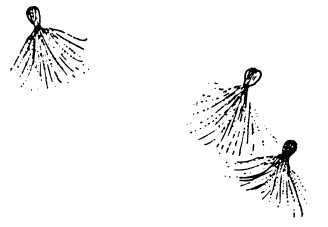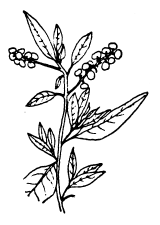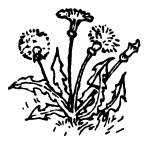Milkweed Ladies (5 page)
Authors: Louise McNeill



W
e had a store calendar on the kitchen
wall, and Granny Fanny's old clock on the mantel struck the hours; but time, as we deeply knew it, was hitched to the circle of the year. It was the old peasant calendar, turning with the earth, from winter to spring, to summer, to autumn, back to winter again.
In the late winter season of freezing nights and thawing days, when water began to sing under the ice, and patches of bare ground opened on the south slope, we had “sugar-makin'” in the Woodland-up-the-Hollow. There on the wooded slope stood the sugar orchard, the scattered maple trees that Captain Jim had forbidden to the loggers; and we would set up our sugar camp in the hollow beside the little spring-fed run.
Before the sugar water began to run, we kids, Ward and Elizabeth and I, would get the sugar wood. We would go up on the woodland slope and drag and roll down the
windfalls and dead limbs. It was cold and back-tearing work to grab the big end of branches two or three times my size and pull them downhill through the openings of the trees, sweeping behind me snow and dirt and leafy piles. Ward and Elizabeth could wrestle even bigger loads and roll big logs down to hold the fire. It took a lot of wood to boil down sugar water, and there was an old saying: “For a barrel of water, a rick of wood; for a jar of molasses, to boil them good.” When dusk came down into the hollow, our work would be done. With our faces and hands scratched, our mittens sodden, and our gum shoes squeaking, we plodded home toward lamplight, hot supper, and our homework for school.
When the sugar thaw came, Mama and Granny Fanny would help us drag our sugar-making gear up-the-hollow: bundles of sumac spiles (spouts), two black kettles, the sawhorses, and the sugar buckets. On a flat below the spring were two sturdy forked posts set deep in the ground, and across them lay a heavy sapling set in the crotches of the posts and fastened with baling wire. On this crosspiece we hung our black chains and pot hooks and hoisted up the two big sugar kettles. Up in the woods, Mama traveled from sugar tree to sugar tree with the brace and bit. She would pick a new spile-place
under each of the biggest limbs to set the bit in, and the pale gold-colored shavings would sprinkle down on the melting snow. The first trickle of sugar water would come from the spile hole and run, darkening, down the trunk. Mama would twist a hollow spile into the hole until it fitted, and hang up the first sap bucket. On days when there was a good run of sap, a tiny stream of water would trickle out of the spiles and the sounds of sweet water would sing in the sunshine and the melting frost runes of the hills.
We kids gathered buckets of sap, moving from tree to tree with our three-gallon buckets. The water sweetened the black pots, and we lit the fire so the sweet water could send up its first wisps of white steam. There was always a big log or two to sit on and rest and watch the fire. We children sat like three ragged blackbirds, dressed in long black stockings, too-small dark coats, and dark stocking caps and black gum shoes. Between bouts of sap collecting, we watched and sniffed the boiling sap water.
Black night would come as the “sweety” began to thicken, and at supper time, we would rake out little beds of coal, five of us, moving busily in our narrow ring of light. We laid thick slices of ham on the sizzling redness and waited and smelled. For dessert,
there would be roasted apples, half burned and half raw, and some cane-molasses cookies from a poke.
In some of these years, G.D. was moonlighting as a bookkeeper for the lumber company, and he would come and join us by late suppertime. Then, with the fire in the center and the black hillsides all around us, we waited for the sugar to boil down. When the sweety began to foam up like it would run over, Granny Fanny would take a piece of fat side meat fastened on a stick and run it back and forth to quiet the roiling waves. It was like the wand in my fairy story book: the whiteness would quiet, bubble softly, and begin to “smoke its pipe,” breaking the bubbles with brown puffs.
Ward and Elizabeth and I would take our lantern and our tin pie pans and go up on the hill to hunt for a patch of clean snow to make wax balls. When Mama dribbled thickening syrup over the snowy mounds we had gathered, the amber wax would harden into clear, maple taffy.
Mama and Granny Fanny knew all the signs exactly: when to skim off the white, dirty froth; when to run the fatback over the roiling kettle; and when to take off the molasses and sugar. When we were “sugaring off,” the hot sugar was stirred and poured into greased pans and “suggins,” to be knocked
out later, when it was cool, and to be stored high on the pantry shelf for sweetening apple dumplings, oatmeal, and pumpkin pie.
After sugar season, we watched eagerly for signs of open spring. One of the first signs was when Granny Fanny went out to the woods to dig up roots for sassafras tea. She put the red roots and pieces of bark in a pot on the back of the stove and boiled her spicy, red tea. We drank it hot and heavily sweetened, and Granny said it would thin our winter blood.

Soon after sassafras time, it was green-up time, with the first shoots coming up out of the ground. We watched the sprouts hopefully, for this was the time of year for Granny to go to the fields and woods to pick her wild greens, the “sallets” of the old frontier. Granny Fanny taught us all the plants, and how to tell the good greens from the bad. We gathered the new poke sprouts, always being careful not to snip them too close to their poison roots; and we gathered “spotted leaf,” leaves of “lamb's tongue,” butter-and-eggs, curly dock, new blackberry sprouts, dandelions, and a few violet leaves. Later the white meadow weed would be good, and the shepherd's purse and milkweed sprouts. It took six gallons of leaves to make a mess of greens, and Granny would boil
them in the black pot, drain off the potlikker, and fry them in hog grease because there was a saying that poke greens must be fried in hog grease or the poke would poison you to death.
Green-up time was also ramp season; but Mama wouldn't let a ramp come into the house, for the ramp is a vile-smelling wood's onion whose odor, like memory, lingers on. Some of our neighbors and cousins hunted ramps every spring and carried them home in gunnysacks to boil and fry. In the spring down at school, the teacher would sometimes have to throw the windows wide open to air out the smell of ramps, wet woolen stockings, and kid sweat.

Sex was never mentioned in our house, but in the barn and barnyard we learned early when the cows were in heatâ“on a rippet,” we called itâand G.D. would drive them to some neighbor's bull. G.D. wrote down on the kitchen calendar when each cow had gone to the bull, and we turned the buck sheep in with the ewes. One time G.D. had a man bring a stallion for old Bird and told us not to cross the fence or come near. The stallion nickered and carried on and jumped up on old Bird, but no colt came. And we saw the frogs breeding in Grandpa Will's pond, and the rooster
jumping on the hens, and the birds breeding, the butterflies, and even the house flies. Then we hunkered in the barn and sheep shed and watched the bloody borning of the lambs and calves.
The earliest lambs were usually March lambs, and the mothers lay on beds of hay tossed down from the mow. The lambs were wet and wobbly at first but would soon be running out in the stubble field, shaking their long tails and playing chase with one another. Sometimes a bad mother sheep wouldn't let her baby suck, wouldn't “claim it,” we said. She would butt him and whirl around from his hungry punching, and he would cry so weak and small. Then we kids would gather him up in our arms and carry him to an old carpet behind the woodbox and feed him bottles of warm milk from the cows. He would become our pet lamb and follow us around all summer, but in the fall we would have to stand by the gate and watch Tom Beard, the cattle and sheep buyer, drive our lamb away with the others to the slaughter pens.
In the spring too, the calves would come and the mother cows had them out in the wild of the pasture, or lying in the shed and looking at us with hurt and feverish brown eyes. The calf would come out slowly, all covered with bloody striffen and clots. Sometimes
G.D. or Mama or Granny Fanny would have to help the calf out, and one time, when the calf wouldn't come, G.D. cut it up in pieces to save the cow. But usually the calves would stand right up; the mother would lick them off with her tongue, and they would begin to punch around and suck.
One summer I had a pure white calf named Lily, from old Bloss, my pink cow. I taught Lily to lead on a rope all around the yard. In the fall, Tom Beard came and drove her away. But before he did, she had moved deep into my mind, so that there has always been there a calf named Lily, white as the mountain snow.
When we saw our first dandelion, we could take off our long winter underwear. When we saw our first bumblebee, we could go barefoot. Then, Easter would come and we had sugar eggs and beet-pickled eggs and the stormy-colored eggs the rabbits laid. Our cousins up at town found red and blue and green rabbit eggs in their yards. One time, when I wanted red and blue eggs, Ward told me that the rabbits up in town were tame, while our rabbits were wild and laid wild stormy-weather eggs between the bumps of tree roots and in the hollows of rocks up in the pasture. Our rabbit eggs
were either a pale rust color or the color of walnut-shell dye, with intricate veins on them like the veins on an onion skin. After Easter, the spring rains came, and the flowers came to their nooks in the woodland, and the bluebirds came back to their holes in the fence posts and gnarly apple trees. The fence and orchard were alive then with the flashing, blue, red-breasted birds.

In April the men went out with their horses and plows to turn the long black furrows. Cousin Rush usually did our plowing with his big team. The furrow rolled black and slick-cut from the plowshare, and the robins would leap down to pull and tug at the new fishing worms. If we had been lucky enough to see a bumblebee, we could run barefoot behind the plow and feel the cool, soft, spring-smelling earth wiggle between our toes.
After the fields and garden were plowed, Cousin Rush would harrow with the old spike-tooth harrow and, at the last, sometimes haul a heavy wooden drag back and forth across the fields to break up the clods. Rush would let me ride on the drag to make it heavier, and I would slide along, playing that I was on G.D.'s U.S.S.
Glacier
sailing into the great Winds of the Williwaw in the Straits of Magellan.
